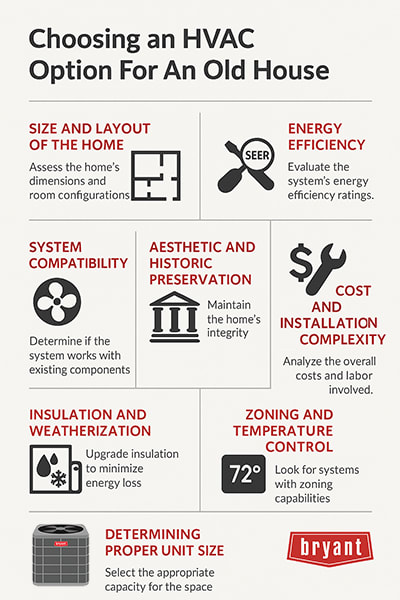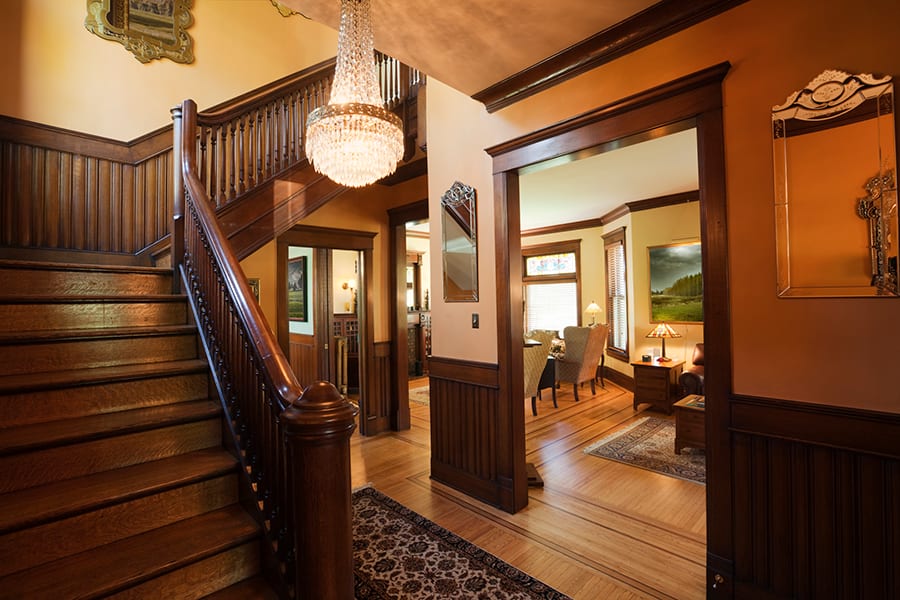About The Author: Travis Baugh is a Digital Brand Marketing Manager for Bryant, where he creates clear, helpful content to guide homeowners through heating, cooling, and indoor air quality decisions. His goal is to empower readers with the knowledge they need to choose the right comfort solutions for their home—confidently and comfortably.
HVAC Options for Old Houses
The most effective HVAC options for old houses—especially those lacking existing ductwork—are typically ductless mini-split systems and Variable Refrigerant Flow (VRF) systems. These solutions provide precise, zoned temperature control and superior energy efficiency while preserving the unique architectural integrity of historic properties.
Retrofitting a modern heating and cooling system into a vintage home is a balancing act between preserving history and ensuring 21st-century comfort. Whether you are renovating a Victorian classic or updating a mid-century gem, understanding your options is the first step toward a more comfortable, energy-efficient future. HVAC installation
Key Considerations When Choosing HVAC for Old Houses

Before selecting a specific system, you must evaluate the unique constraints of your property. Older homes were not designed with modern climate control in mind, which presents specific challenges regarding space, preservation, and efficiency.
Does the Home Have Room for Ductwork?
Many older houses lack the wall or ceiling space required for traditional bulky ductwork. Installing central air conditioning in these structures often requires major renovations, such as lowering ceilings or building bulkheads, which can disrupt the home’s layout. A professional HVAC assessment can determine if your home can accommodate ducts or if a ductless solution is necessary.
How Important is Historic Preservation?
If maintaining your home’s original crown molding, plaster walls, and hardwood floors is a priority, you need an HVAC system with a minimal footprint. Non-invasive options like ductless mini-splits prevent the need to cut large holes in floors or walls, keeping your home's character intact.
What Are Your Energy Efficiency Goals?
Older homes often suffer from drafts and poor insulation, leading to higher energy bills. Choosing a high-efficiency system is crucial to offset these losses. Look for units with high SEER2 (Seasonal Energy Efficiency Ratio), HSPF2 (Heating Seasonal Performance Factor), or AFUE (Annual Fuel Utilization Efficiency) rating can help reduce heating and cooling costs and improve overall comfort.
“Ductless mini splits are much more energy efficient than central air units because you can run them room by room instead of conditioning the entire home,” Brian Redmond, owner of Redmond’s Complete Comfort in Lock Haven, Pennsylvania.
Is Zoning Required for Comfort?
Multi-story older homes are notorious for uneven temperatures—sweltering upstairs bedrooms and freezing downstairs living areas. Zoning allows you to control the temperature in different areas independently, solving the comfort imbalance inherent in older architecture.

Top HVAC System Types Suitable for Old Houses
When weighing HVAC options for old houses, two technologies stand out for their flexibility and efficiency: Ductless Mini-Splits and VRF Systems.
1. Ductless Mini Split Systems
Ductless mini split systems are frequently the top recommendation for historic renovations. They consist of an outdoor compressor connected to indoor air-handling units via a small conduit, eliminating the need for large air ducts.
- Preserves Aesthetics: Installation requires only a small 3-inch hole in the wall, preserving your home's structural integrity.
- Zoned Comfort: Each indoor unit operates independently, allowing you to cool the kitchen without freezing the study.
- High Efficiency: By removing ducts (where up to 30% of energy loss can occur), ductless systems deliver lower energy bills.
2. VRF (Variable Refrigerant Flow) Systems:
VRF systems are an advanced solution often used in larger historic properties. They use sophisticated technology to circulate only the precise amount of refrigerant needed to each zone.
- Customizable Design: Air handlers can be hidden in ceilings, walls, or floors, offering discreet comfort that doesn't clash with vintage decor.
- Simultaneous Heating and Cooling: Advanced VRF systems can heat one room while cooling another, perfect for homes with complex layouts and sun exposures.
- Quiet Operation: Designed for minimal noise, these systems maintain the peaceful atmosphere of your home.

Work With A Bryant Dealer On HVAC Options For Old Houses
Preserving the legacy of an old house requires expertise. Retrofitting HVAC systems involves navigating unique structural challenges like plaster walls, limited electrical capacity, and strict preservation guidelines.
Your local Bryant dealer understands these nuances. By choosing Bryant, you are investing in a system designed to protect your home’s value while delivering the reliable, modern comfort you deserve.
Ready to breathe new life into your old home? Your local Bryant dealer today to learn more about how we can help you maintain the charm and character of your old house while enjoying modern comfort and efficiency.
HVAC Options For Old Houses FAQs
Yes, you can install an HVAC system in an old house, though it may require custom ductwork, electrical upgrades, or using ductless systems to accommodate the existing structure.
The most efficient method is often a ductless mini-split system, which avoids invasive ductwork and allows for zoned comfort and energy savings.
Installing central air in an old house can be challenging due to tight spaces, lack of ductwork, and historic building materials, often increasing labor and cost.
Adding ductwork to an old house typically costs between $5,000 and $15,000, depending on the home size, layout complexity, and whether walls or floors must be opened. It’s best to talk to your local Bryant dealer to get an accurate quote.
Learn More About HVAC
- Explore the value of what is HVAC?
- Read our guide on HVAC replacement
- Check out our HVAC pricing guide
- Learn how long HVAC systems work
- Get help with HVAC repair
- Find out more about HVAC service


